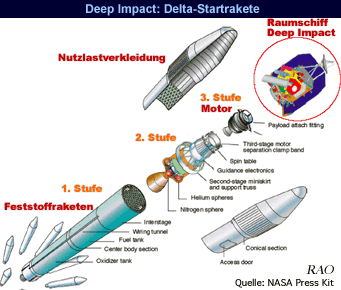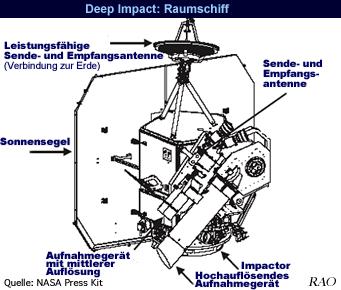|
|
| Weltraum - Raumfahrt |
| National Aeronautics and Space Administration NASA - USA |
 |
|
|

|
  |
(7.5 feet) high Weight: 601 kilograms (1,325 pounds) at launch, consisting of 515 kilograms (1,135 pounds) spacecraft and 86 kg (190 lbs) fuel Power: 2.8-meter-by-2.8-meter (9-foot-by-9 foot) solar panel providing up to 750 watts, depending on distance from Sun. Power storage via small 16-amp-hour rechargeable nickel hydrogen battery Impactor Dimensions: 1 meter (39 inches) long, 1 meter (39 inches) in diameter Weight: 372 kilograms (820 pounds) at launch, consisting of 364 kilograms (802 pounds) spacecraft and 8 kilograms (17 pounds) of fuel Power: Non-rechargeable 250-amp-hour battery
Nucleus size (estimated): 14 by 4.6 by 4.6 kilometers (9 by 3 by 3 miles) Nucleus mass: Unknown; possibly about 1 trillion kilograms (roughly 1 billion tons) Nucleus rotation period: About 41.85 hours Nucleus composition: Theory and observations of other comets suggest silicate dust (~25%), organics (~25%), ices (40%), other material (10%) ) |
| Mission |
| Launch: Jan. 12, 2005 Launch site: Cape Canaveral Air Force Station, Florida Launch vehicle: Delta II 7925 with Star 48 upper stage Earth-comet distance at time of launch: 267 million kilometers (166 million miles) Comet impact: 1:52 a.m. EDT July 4, 2005 (time subject to adjustment) Earth-comet distance at time of impact: 133.6 million kilometers (83 million miles) Total distance traveled by spacecraft from Earth to comet: 431 million kilometers (268 million miles) Closing speed of impactor relative to comet nucleus at time of impact: 37,100 kilometers per hour (23,000 miles per hour) End of mission: Aug. 3, 2005 (30 days after impact) Program Cost: $333 million total (including launch vehicle |
| Weitere Informationen |
|
|
|

|
|
|
|
|